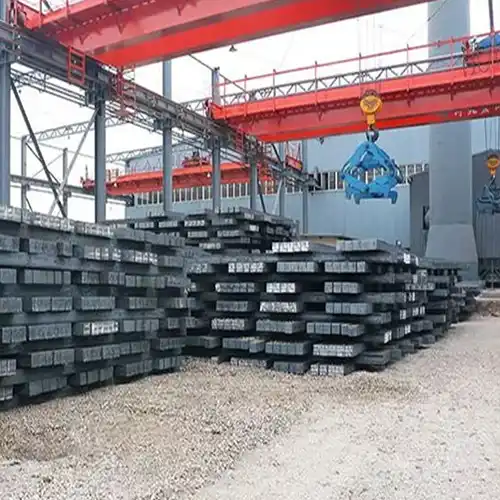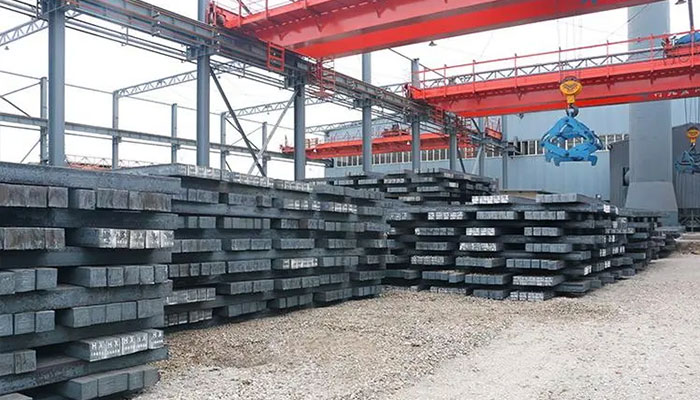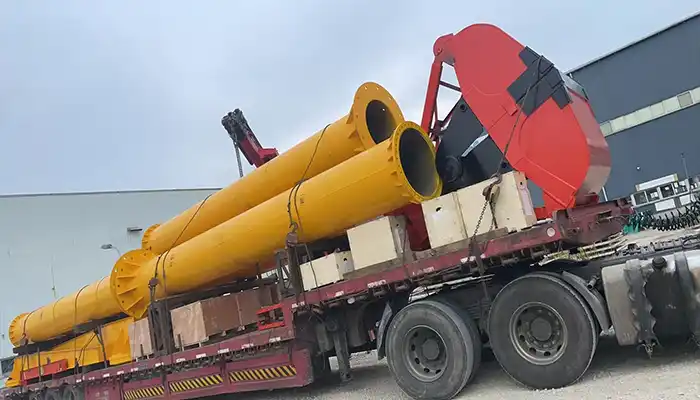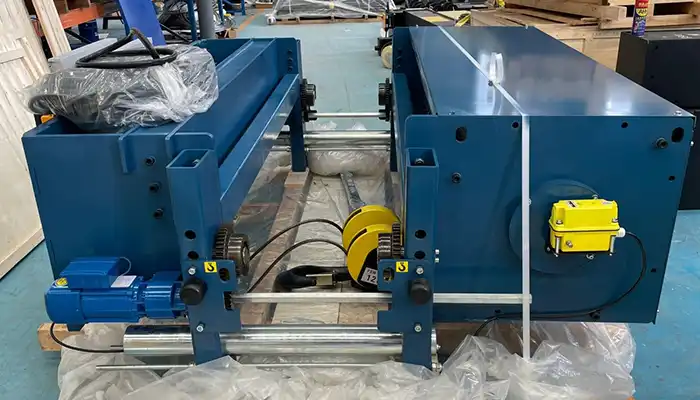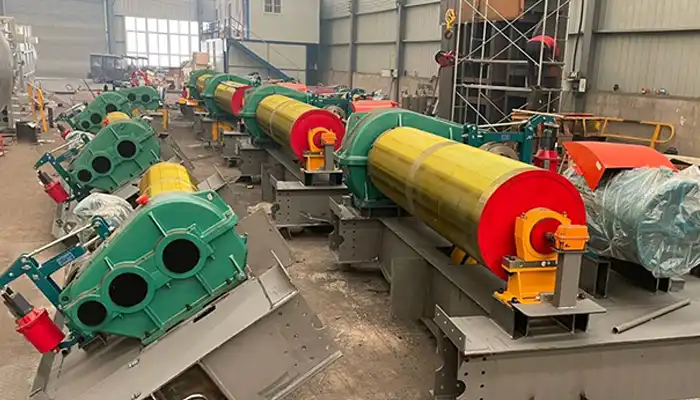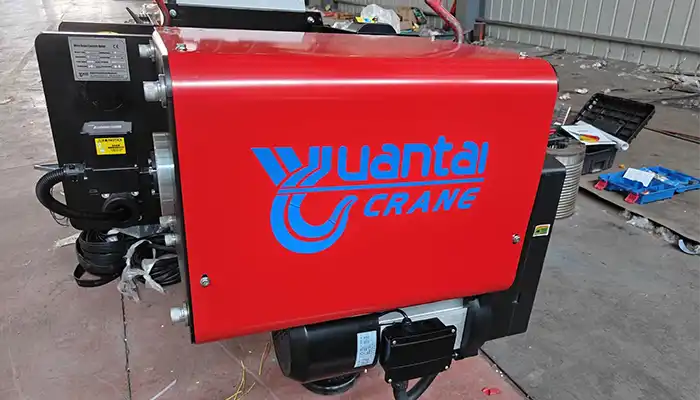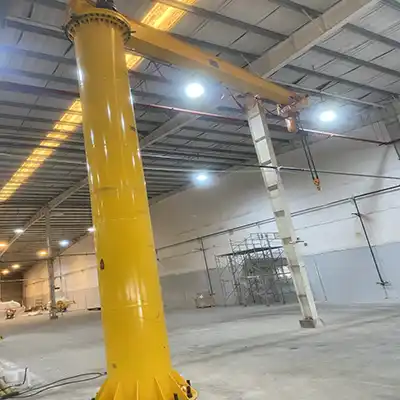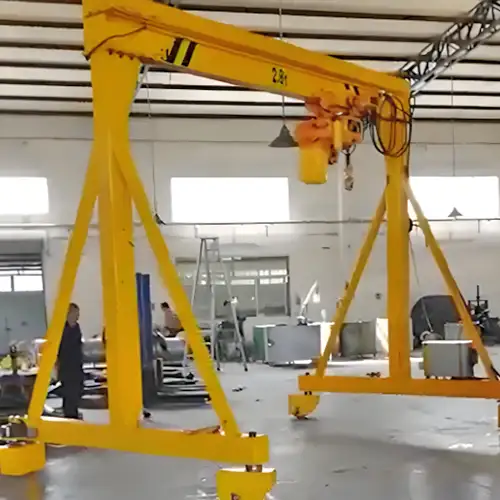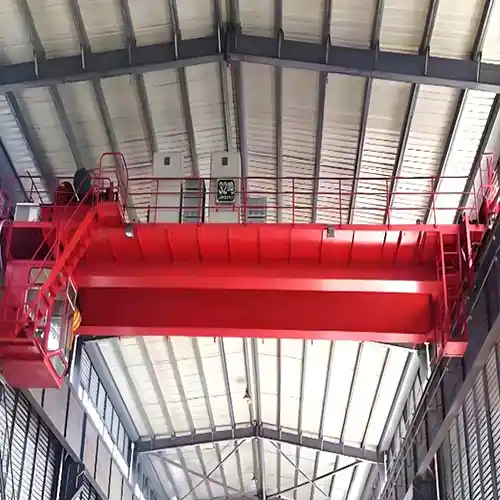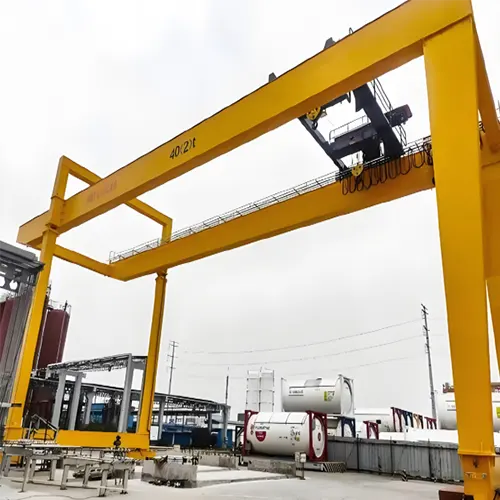Slab Handling Crane: Customized Options for Diverse Needs
Custom slab handling cranes optimize safety, efficiency, and productivity by adapting to specific slab sizes, weights, and environments.
Category: Featured
Custom slab handling cranes optimize safety, efficiency, and productivity by adapting to specific slab sizes, weights, and environments.
Overview of Slab Handling Cranes
Slab handling cranes are vital in industries like steel and metal production. These cranes lift and move heavy slabs of metal, steel, or concrete in manufacturing plants, mills, and construction sites. Their job is to safely transport large, heavy materials that are essential in these industries.
Slab handling cranes come in many shapes and sizes. The design of these cranes must fit the unique needs of each facility. A crane that works well in one factory might not be suitable for another because the size of the slabs, the weight, or the environment can vary greatly.
Key Challenges in Handling Slabs
Handling slabs presents some serious challenges:
- Size: Slabs can be extremely large, requiring cranes with wider spans and higher lifts to move them safely.
- Weight: Slabs are often very heavy, so cranes must be built to handle substantial loads without compromising safety or efficiency.
- Environmental Factors: In many steel mills or foundries, conditions are harsh. Extreme temperatures, humidity, and dust can all affect crane performance and durability. Cranes need to be designed to work in these tough environments without breaking down.

Gantry crane with slab handling tongs
Importance of Customization
Customization makes all the difference when it comes to slab handling cranes. Every facility has different needs, and a one-size-fits-all crane just doesn't work.
- Better Performance: A customized crane is built to match the specific demands of your workspace. Whether it's for handling bigger slabs or working in a hotter environment, a tailored crane will perform better.
- Safety First: Slab handling involves risks. A customized crane can include safety features like anti-collision systems, improved load handling, or better controls, ensuring safer operation.
- Boosted Productivity: When a crane is built to handle specific tasks, it works more efficiently. This means less downtime, faster operation, and ultimately, higher productivity.
Customization isn't just about making cranes look different. It's about making them work better for the job at hand. Different industries, environments, and slab types all need specific features. Customization helps meet these needs head-on, improving the overall workflow and safety of operations.
Slab Handling Requirements
Slab Size Variations
Slabs come in all shapes and sizes, and the size of the slab plays a big role in how it's handled. In steel mills, you might have slabs that are small and manageable, but other times you'll be dealing with massive slabs weighing tons.
- Large Slabs: Large slabs require cranes with wider spans, higher lift capacities, and longer hook heights. These slabs need careful handling because of their size. A single girder crane may not be enough, and you might need a double girder crane to provide the necessary lift and stability.
- Small Slabs: Smaller slabs might not require as much lifting capacity, but precision is key. These slabs need cranes that are more agile and can handle shorter spans and lighter loads. Single girder cranes or smaller bridge cranes are often better suited for these tasks.
Different Crane Configurations:
- Single Girder Cranes: Typically used for smaller slabs, single girder cranes are lightweight, cost-effective, and perfect for tight spaces. They are ideal for small to medium-sized slabs.
- Double Girder Cranes: Used for heavier and larger slabs, double girder cranes provide more stability and greater lifting capacity. They are often the choice for handling large, heavy slabs in larger production environments.
Each slab size demands specific crane features to ensure safe and efficient handling. Matching the crane to the slab size reduces risks and improves overall productivity.
Weight Considerations
Slabs are heavy. Some slabs can weigh several tons, and that's where weight considerations become critical. The weight of the slab determines the type of crane needed to lift it safely.
- Heavy-Duty Lifting Cranes: For very heavy slabs, cranes must be designed with stronger materials and better lifting mechanisms. Hoists and hoist drums must be built to handle more load, and the lifting capacity must be precisely calculated to prevent failure.
- Customization Based on Weight: Customization allows cranes to be built with specific lifting capacities tailored to the weight of the slabs being handled. Some slabs require cranes with special lifting mechanisms, such as high-capacity winches, to ensure the crane can manage the load.
Customized cranes for heavy-duty lifting may also include features like:
- Reinforced steel frames.
- Special lifting hooks or grabs to handle irregularly shaped slabs.
- Hoists with increased motor power for smoother lifting.
Understanding the exact weight of the slabs helps to design a crane that can handle the load without unnecessary wear and tear, extending the crane's lifespan.
Environmental Factors
Cranes don't operate in a vacuum. The environment where the crane is used plays a huge role in its design and functionality. Steel mills, foundries, and other industrial sites can have extreme working conditions.
- Temperature Extremes: Many steel mills operate in high-temperature environments, where ambient heat can affect crane components. Cranes might need special coatings to resist heat or high-temperature lubricants to keep the moving parts running smoothly.
- Humidity and Corrosion: In areas where humidity levels are high, corrosion can become a big issue. Cranes might require additional corrosion-resistant materials like stainless steel, or special coatings to protect metal parts from rusting.
- Dust and Particles: In environments with high amounts of dust and particles, cranes need to be designed with sealed, protected electrical components to prevent malfunctions. Dust-tight control panels or filters can be installed to keep the crane's sensitive parts from being damaged.
Design Features for Harsh Conditions:
- Temperature Control: Heat-resistant parts, special cables, and improved cooling systems to ensure safe operation in extreme heat.
- Weatherproofing: Sealed electrical components, corrosion-resistant frames, and coatings to protect against moisture and dust.
- Heavy-Duty Bearings and Gears: To keep the crane operating smoothly in challenging conditions, specialized bearings and gears that can handle grit, dust, and temperature extremes are often required.
Environmental factors can make a big difference in how long a crane lasts and how well it performs. Customizing cranes to meet these conditions ensures that the crane can work reliably in tough environments without constant breakdowns or maintenance issues.
In the end, every slab handling crane needs to be designed with these critical considerations in mind to ensure it can handle the unique demands of the job.
Benefits of Customization
Improved Safety
Safety is always a top priority in any industrial operation, especially when dealing with heavy slabs. Customizing slab handling cranes allows you to integrate specific safety features designed to reduce the risks associated with moving large, heavy materials.
- Tailored Safety Features: Different environments and tasks require different safety measures. For example, cranes working in steel mills can be fitted with heat-resistant cables and components to prevent accidents caused by high temperatures. Additionally, customized safety features like anti-collision systems or load sensors ensure that the crane operates safely, even when moving large slabs through tight spaces.
- Reducing Accident Risks: A customized crane reduces the risk of accidents due to mishandling or inadequate design. When a crane is designed to match the specific size, weight, and environmental conditions, it's easier to ensure safe operation. Custom cranes can include features like automatic load limiters to avoid overloading and safety brakes that activate in case of malfunction.
By addressing specific safety concerns through design, customized cranes help protect both workers and equipment from accidents.
Enhanced Efficiency
Customization can significantly improve the efficiency of slab handling operations. Every feature of a custom crane is designed to perform a particular task more effectively, leading to smoother and faster operations.
- Optimizing Crane Movement: Custom designs can be tailored to ensure the crane moves efficiently within the workspace. Adjusting the span, lift height, and speed settings allows for smoother travel, reducing unnecessary pauses or jerky movements. These improvements minimize the time spent moving slabs from one point to another.
- Reducing Downtime: With customized features such as advanced hoist systems, optimized motors, and precise control systems, the crane operates more reliably. This reduces the chances of breakdowns and ensures that production doesn't slow down due to equipment issues. Moreover, quicker response times and better load control reduce the need for manual handling, which also cuts down on downtime.
Customization enables cranes to work more effectively and consistently, speeding up slab handling and lowering operational costs.
Increased Productivity
Customization isn't just about safety or efficiency—it directly impacts the productivity of your facility. A crane built to handle specific loads and environments can increase the overall output by reducing delays and improving crane reliability.
- Maximizing Load Capacity: A customized crane is designed with the appropriate lifting capacity to handle heavy slabs without issue. This means it can manage the highest loads in your facility without overloading or risking a breakdown. With the right crane, production lines can run without interruption.
- Meeting High-Output Demands: High-output production lines require fast, reliable equipment. Custom cranes can be optimized to handle the specific weight and size of slabs used in these environments, allowing for faster cycles and minimizing waiting time. Whether it's lifting multiple smaller slabs or a few large ones, customized cranes can move materials quickly and with precision, supporting high throughput.
Customized cranes help meet the unique demands of each facility, enabling faster, more efficient operations that keep up with the pace of production. By maximizing load capacity and minimizing downtime, customized cranes directly boost overall productivity.
Customization Options for Slab Handling Cranes
Design Variations
The design of a slab handling crane is one of the first steps in customization. Depending on the facility's needs, the crane's structure can be tailored to handle different slab sizes, weights, and operating conditions.
Single vs. Double Girder Configurations:
- Single Girder: Single girder cranes are more lightweight and cost-effective. They are ideal for smaller slabs or low-duty operations where space is limited. However, they have a lower lifting capacity and are best suited for handling lighter loads in confined areas.
- Double Girder: Double girder cranes provide higher lifting capacity and stability. They are better suited for handling heavy, large slabs, especially in large production environments like steel mills. They offer more durability and are capable of handling the heavy-duty lifting required for large steel or concrete slabs.
Adjusting Span, Lift Height, and Hook Height:
- Span: The span refers to the distance between the rails on which the crane travels. Customizing the span ensures that the crane can reach all areas of the workshop or mill, depending on the width of the space.
- Lift Height: Adjusting the lift height ensures that the crane can move slabs to the required elevations, whether it's for loading, unloading, or stacking.
- Hook Height: Hook height customization helps in providing the necessary clearance for lifting slabs in high-clearance spaces, such as in foundries where heat-resistant cranes are required.
By customizing these parameters, you ensure that the crane fits the specific needs of the facility, whether it's for compact spaces or high-clearance areas.
Lifting Mechanism Customization
The lifting mechanism is one of the most important aspects of a slab handling crane, and customizing it can greatly improve performance.
Hook Block and Hoist Options:
- Hook Block: Customizing the hook block allows for the crane to securely hold slabs of various shapes and sizes. Different hook designs can be used depending on the type of slab being lifted. Some hooks might include padding or special grips to prevent damage.
- Hoist Options: Depending on the weight of the slabs, the hoist system may need to be adjusted to include stronger motors or more durable gears. A hoist built to handle heavy loads ensures smoother operation, especially when lifting large, dense slabs.
Specialized Grabs, Magnets, or Vacuum Lifters:
- Grabs: Custom grabs can be designed to handle irregularly shaped or unusually heavy slabs, ensuring a secure and firm grip during lifting.
- Magnets: For steel slabs, magnetic cranes can be used. Magnets securely lift ferrous materials, reducing the risk of damage during lifting and ensuring faster operations.
- Vacuum Lifters: These are used for lifting non-ferrous materials like aluminum or delicate concrete slabs. The vacuum lifter uses suction to securely hold slabs without damaging their surfaces.
These custom lifting mechanisms improve precision, reliability, and safety, ensuring slabs are handled in the most efficient way possible.
Control Systems
Control systems play a crucial role in ensuring precise and safe handling of slabs. Customizing the control systems can enhance operation and minimize the chance of human error.
Custom Control Systems for Improved Precision:
- Customizing the control system ensures that the crane can perform delicate or precise movements when lifting and placing slabs. Features like speed regulation, load monitoring, and programmable settings can be incorporated to make sure the crane operates at optimal performance.
Control Options:
- Radio Remote Control: Radio remotes allow operators to control the crane from a safe distance, reducing the risk of accidents and improving visibility. This is especially useful in environments where operators need to avoid hazardous areas.
- Pendant Control: Pendant control allows operators to stay close to the crane while maintaining precise control. This option provides flexibility for operations where close monitoring of slab handling is necessary.
By customizing control systems and control options, operators can safely and accurately handle slabs with minimal intervention, improving overall efficiency and safety.
Material Handling Features
Customization of material handling features ensures that cranes can safely and efficiently lift and move slabs of different types and materials.
Modifying Lifting Hooks or Slings for Specialized Slab Types:
- Steel Slabs: For steel slabs, customized lifting hooks or slings may be used. These hooks might be designed with additional grip or strength to handle the weight and smooth surface of steel slabs without causing damage.
- Concrete Slabs: For concrete slabs, custom slings with softer, more cushioned surfaces may be required to prevent surface damage or cracking.
Custom Attachments for Extra Stability and Balance:
- Additional attachments like lifting beams or counterweights can be incorporated to stabilize the crane and ensure a secure lift, especially for larger or heavier slabs. These attachments help balance the load evenly, preventing any tilting or instability during the lifting process.
Custom material handling features ensure that different types of slabs are handled correctly without risking damage to the material or compromising safety.
Selecting the Right Slab Handling Crane
Assessing Operational Needs
When selecting a slab handling crane, it's important to evaluate the specific requirements of your production environment. The crane must be capable of handling the size, weight, and type of slabs your operation deals with, as well as the conditions in which it operates.
- Identify Slab Dimensions and Weight: Start by assessing the typical size and weight of the slabs that need to be lifted. For larger, heavier slabs, you may require a double girder crane with higher lifting capacity, while smaller slabs might only require a single girder crane.
- Consider the Production Environment: The environmental factors, such as temperature, humidity, and space constraints, should be considered. Steel mills or foundries, for example, require cranes designed to withstand extreme heat or corrosion, while more controlled environments may not require such heavy-duty features.
- Operation Frequency: The frequency of crane use is also a key factor. If the crane will be used in a high-output production line, then a high-speed, high-capacity crane will be required to meet operational demands.
By evaluating these factors, you can determine the right crane configuration that will meet both your immediate and future needs efficiently.
Cost vs. Benefit Analysis
Choosing the right slab handling crane often involves balancing the initial cost of the crane and its customization against the long-term productivity gains and safety improvements it can offer.
- Initial Cost of Customization: Customizing a crane can increase the upfront cost, as specialized components and features are added. For example, opting for a crane with a heavier lifting capacity or advanced safety features will increase costs.
- Long-Term Productivity Gains: While the initial investment may be higher, a customized crane can lead to significant long-term benefits. A crane tailored to your specific slab handling needs can improve efficiency, reduce downtime, and extend the lifespan of both the crane and the slabs being handled. This leads to lower operational costs and a better return on investment over time.
- Safety and Reduced Accidents: Customizing for safety can also save on potential accident-related costs. Slab handling accidents can lead to equipment damage, production delays, and injuries. A crane built to fit the specific needs of the operation reduces these risks, which in turn can save on insurance and medical costs.
Ultimately, the benefits of a customized slab handling crane far outweigh the initial costs when you factor in improved productivity, safety, and efficiency.
Supplier Considerations
Selecting the right supplier is essential to ensure you get the most out of your customized slab handling crane. You need a supplier who can meet your specific requirements and deliver a high-quality product that will perform reliably in your environment.
- Experience and Expertise: Look for suppliers with a proven track record of providing cranes for slab handling, particularly in industries like steel or metal production. Experienced suppliers will understand the unique challenges and customization needs of your operation and be able to provide the best solution.
- Certifications and Quality Assurance: Ensure that the supplier holds relevant certifications, such as ISO or CE, which guarantee that the crane meets international safety and quality standards. A supplier with these certifications indicates they prioritize safety, quality, and reliability in their manufacturing processes.
- Tailored Solutions: Choose a supplier who offers customized crane solutions rather than one-size-fits-all models. A good supplier will work with you to understand your specific needs and will offer personalized designs, tailored lifting mechanisms, and control systems that match your operational goals.
- After-Sales Support and Maintenance: It's also important to consider the supplier's after-sales services. Will they provide ongoing maintenance, spare parts, and support? A supplier who offers comprehensive post-sale services ensures that your crane will remain operational for years to come.
Choosing the right supplier ensures that you receive not only a high-quality, tailored crane but also the ongoing support needed to keep it running smoothly and efficiently.
Case Studies and Applications
Slab handling cranes are crucial in industries where heavy materials need to be moved safely and efficiently. Steel mills and other heavy industries often need customized cranes to meet the demanding nature of slab handling. Here are a few examples from the industry that highlight the impact of customization:
Steel Mills:
- Case Study 1: A steel mill in South America was dealing with the challenge of handling large, hot slabs weighing up to 30 tons. They needed a crane that could lift these slabs safely in high temperatures while keeping up with production speed. The solution was a double girder crane made with heat-resistant materials and a heavy-duty lifting mechanism. This customization not only improved safety by reducing the risk of accidents in the extreme heat but also boosted productivity by cutting down slab handling time. As a result, the mill increased its output by 25%.
- Case Study 2: Another steel mill had issues with space constraints while needing to handle smaller slabs. They decided to go with a single girder crane that featured an adjustable span and hoist configurations. This allowed the crane to navigate tight spaces and still lift slabs effectively. The customized crane made operations more flexible and reduced downtime by 15%.
Foundries:
- Case Study 3: A foundry that specializes in metal casting needed a crane capable of lifting slabs of different sizes and weights—from small metal slabs to large, heavy castings. They customized the crane with specialized grabs and hoist options to handle these varying materials. The result was faster and more accurate slab handling, reduced manual labor, and improved safety. This custom solution also increased production capacity.
These examples show how customizing slab handling cranes can improve both safety and productivity, allowing companies to tackle specific operational challenges more effectively.
Client Testimonials or Success Stories
Hearing from clients who have benefited from customized crane systems provides valuable insights into how these solutions work in the real world.
- Client Testimonial 1:
"We were having trouble with delays in moving heavy slabs across our production line. Our old crane system wasn't up to the task. After working with a supplier to customize a double girder crane with lifting magnets, we immediately saw an improvement in both safety and productivity. The crane now handles larger loads effortlessly, and it's built to withstand the heat in our steel mill. We've been able to increase our output by 20%, and the workers feel much safer knowing the crane is designed for our specific needs."
— Operations Manager, Steel Mill - Client Testimonial 2:
"The single girder crane we had didn't work well for our small slab production line, especially in tight spaces. By customizing the span and hook height, the crane became much more efficient. These adjustments allowed us to use the crane more effectively, and we avoided expensive downtime. Our slab handling process has been much smoother since, and we've reduced operational delays by 30%."
— Production Supervisor, Foundry - Client Testimonial 3:
"We were having issues with lifting concrete slabs that needed extra care. The solution was a custom vacuum lifter system, specifically designed for our needs. The crane's attachments now let us lift and transport delicate slabs without any damage. It's made a huge difference in our operations, reducing product defects and boosting our throughput."
— Plant Manager, Concrete Manufacturer
These testimonials highlight the real-world benefits of customizing slab handling cranes to meet unique operational needs. Not only do these customized systems improve efficiency and safety, but they also enhance overall productivity.
Conclusion
Customizing slab handling cranes is essential for improving the overall performance of industries that handle heavy materials. The right crane, tailored to meet specific operational needs, can greatly enhance safety, efficiency, and productivity.
- Crane Customization: Tailoring cranes for different slab sizes, weights, and environmental factors helps ensure smoother operations.
- Safety Benefits: Custom features like specialized lifting mechanisms, safety controls, and materials improve worker safety and reduce accidents.
- Increased Efficiency: A well-designed crane optimizes movement, reduces downtime, and minimizes manual labor.
- Productivity Gains: Customized cranes enable higher production output and more reliable performance under varying conditions.
Investing in customized slab handling cranes is a long-term strategy that pays off in many ways. Though customization might involve a higher initial cost, the benefits it brings—such as improved safety, increased productivity, and operational efficiency—are invaluable in the long run.
- Long-Term Gains: Customized cranes improve safety, reduce maintenance costs, and maximize operational uptime.
- Efficiency and Productivity: A tailored crane ensures quicker handling of slabs and fewer disruptions, increasing the overall output of your facility.
- Cost-Effectiveness: Over time, the reduction in accidents and downtime makes the investment worthwhile.
Now is the time for businesses to take a closer look at their slab handling needs. Consider evaluating your operational challenges and exploring the wide array of crane customization options available. A customized crane system will not only address your current needs but also set the foundation for future growth and success in your operations.
Main Projects
Related Products
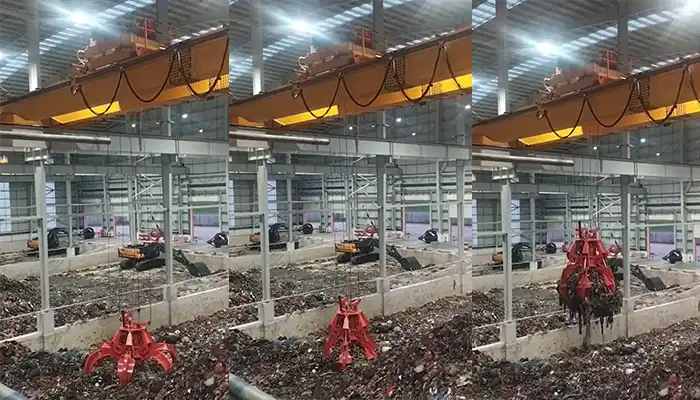
Supplied three grab bucket crane kits to Indonesia, enhancing garbage handling efficiency with high load capacity and reliable performance.
Free consultation to Confirm Parameters & Specifications and Get
Latest Crane Price & Crane Rate.
- Types of overhead cranes : _______?
- Optional: Overhead travelling crane, goliath gantry crane,Slewing jib crane, Single girder or double girder crane,small portable crane or kbk crane, etc.
- Capacity of overhead crane: _______?
- Optional: 0.25ton, 0.5 ton, 1 ton, 2 ton, 3ton, 5 ton, 10 ton,15ton, 20ton, 25 ton, 30ton,35ton, up to 550ton, etc.
- Crane span & lifting height : _______?
- Crane travelling length : _____?
- Control of overhead crane:_______?
- Optional: pendant/ remote/cabin control
- Voltage supply of overhead crane:_____?
- Eg,: 380V50/60HZ,3Phase or others,etc.
- Application/usage of crane:_______?
- Eg,: Steel mill, ,injection mold, cement,stone, concrete,granite, general manufacturing, etc.
Just leave a message via the contact form and our hoist and crane engineer will contact you with in 24working hours.
Get In Touch
